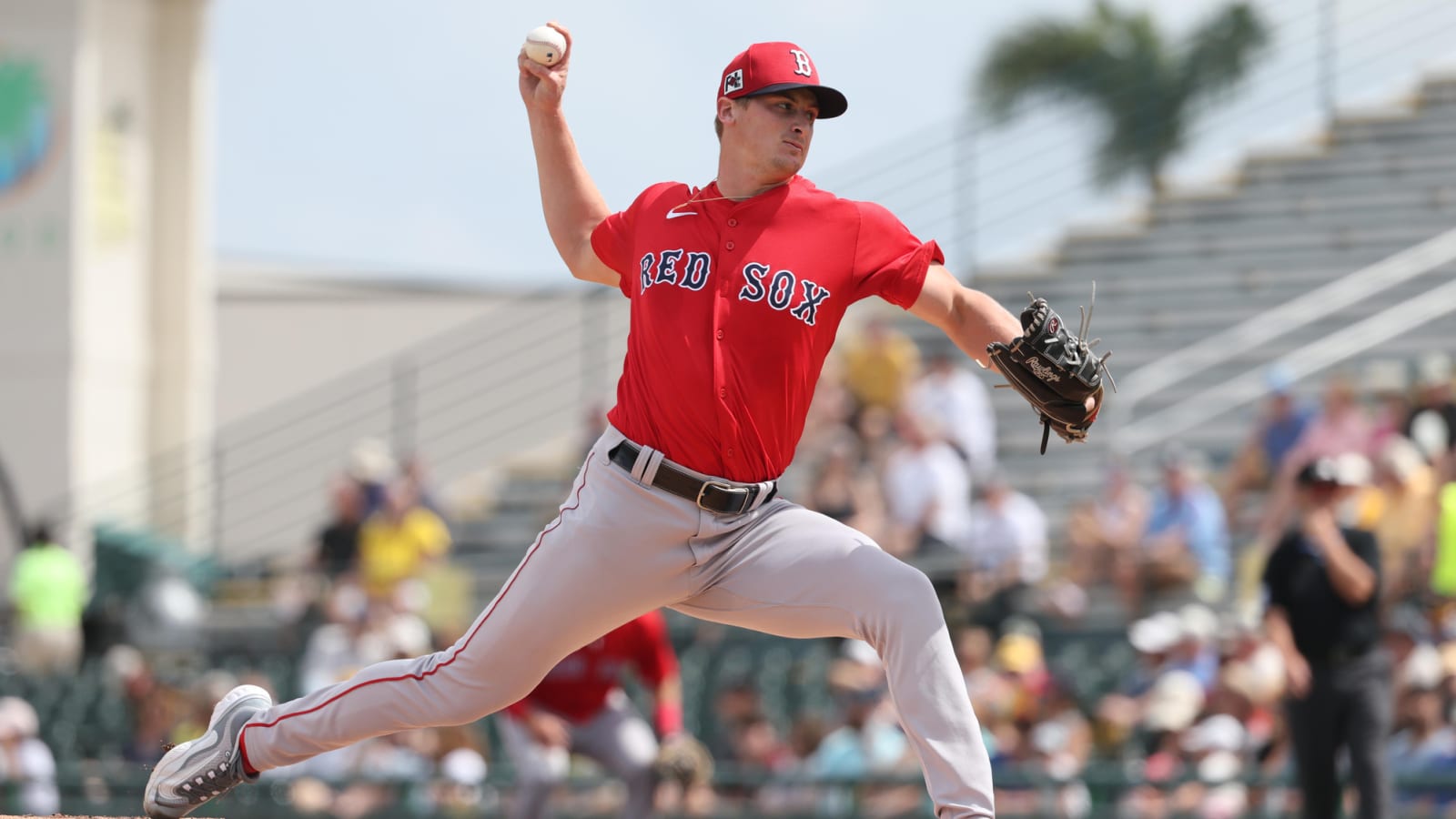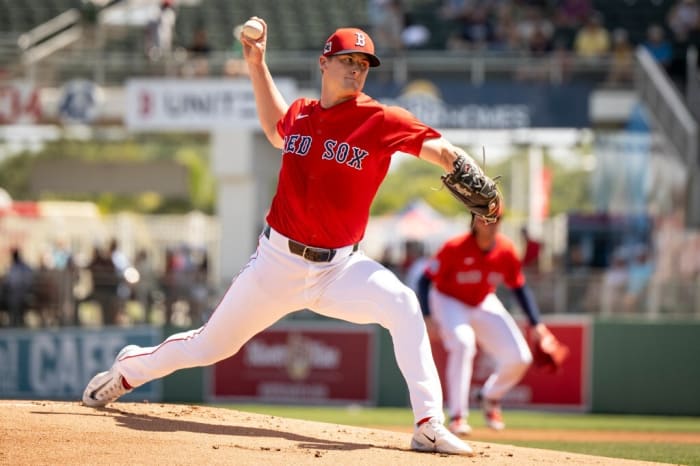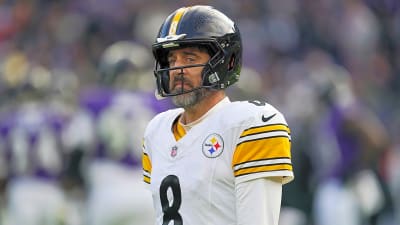
The Milwaukee Brewers typically don’t make moves out of desperation. Whenever their depth has been tested in the past, they’ve been able to address such adversity by embracing a next-man-up mentality. They get the most out of their internal options, and their ability to do so has played an integral role in the ball club’s success.
However, their depth has never been tested to this degree.
Milwaukee’s rotation is completely decimated at the moment. They have a whopping seven starters currently on the injured list, including Nestor Cortes, Tobias Myers, Aaron Civale, Aaron Ashby, Brandon Woodruff, DL Hall, and Robert Gasser.
Freddy Peralta is the only healthy starter remaining from their Opening Day rotation.
As a result, the Brewers needed to find an answer to their rotation woes, and they needed to do so quickly.
So when the Brewers swung a trade for right-hander Quinn Priester on Monday morning, it was a desperate attempt to keep the big-league rotation afloat. But just because the trade was a break from their usual way of operating doesn’t mean that it was a bad one.
The Brewers need all the help they can get at the moment, and while they paid a hefty price tag, the organization clearly views Priester as an arm who can help them remain competitive in 2025 and beyond.
The Brewers Get Rotation Depth, but at What Cost?
When the deal was officially announced, it sparked a good amount of confusion and dialogue amongst Milwaukee’s fanbase for a multitude of reasons, and rightfully so.
In exchange for Priester, the Brewers sent Boston outfield prospect Yophery Rodriguez, a Competitive Balance Round-A selection, and a player to be named later or cash considerations.
Generally speaking, the Brewers have been on the other side of these transitions in years past. But that speaks volumes to just how concerned they are with their big-league rotation.
Rodriguez, 19, was Milwaukee’s No. 5 prospect heading into 2025, and he was even a member of the final update to Just Baseball’s Top 100 prospect list a few months ago. Rodriguez has yet to make it above High-A, but he’s showed an intriguing skillset throughout his young professional career.
He had the potential to be a piece of the Brewers’ big-league outfield down the road. However, the Brewers already have plenty of young, controllable outfield options at the major league level. While there’s no denying what kind of player he could develop into later on, he’s a player who was still years away from his major league debut at a position of strength within the Brewers’ organization.
Whether or not the Brewers got enough for Rodriguez is debatable, but they clearly deemed him as an expendable asset and capitalized on an opportunity to flip him in order to improve the major league rotation.
The most puzzling part of the entire package was the competitive balance pick that the Brewers sent along with Rodriguez.
Perhaps no team in MLB values their draft capital more than Milwaukee. They’ve built a large portion of their current major league core through recent drafts, as well as established one of MLB’s deepest farm systems by hitting on draft selections.
So to see them part ways with the No. 33 overall selection in the upcoming draft, on top of moving on from their top outfield prospect, seemed like an enormously rich price tag.
Milwaukee does still own five selections within the top 100 picks after the Priester transaction, so having an abundance of draft selections likely made it a bit easier to pay the price that the Red Sox were asking for.
But once again, that should tell you all you need to know about how the Brewers view their current pitching situation — not just in 2025, but moving forward as well.
Priester’s Impact in 2025 and Beyond
As it currently stands, the Brewers’ starting rotation consists of Peralta, Tyler Alexander, Elvin Rodriguez, and Chad Patrick.
Alexander and Patrick have done well in their handful of starts to this point, but there’s obvious risk in relying upon those two arms to be focal points in the rotation. However, the Brewers may have no choice but to hope they can maintain that efficiency until some of their regular starters return to the mound.
Rodriguez, who was forced into the rotation as a result from all of the injuries, has struggled mightily in his first two turns through the rotation. In his two outings (nine total innings), Rodriguez has surrendered 11 runs (11.00 ERA) and 14 hits, including five home runs.
The Brewers have been so successful over the years due to their ability to find arms who can keep them in games and eat innings, but Rodriguez has not demonstrated an ability to do so. One would think his performance contributed to the organization’s decision to swing this trade.
Myers, Civale, and Woodruff are slowly working their way back to the mound, and Jose Quintana is building himself up in the minor leagues. Quintana is eligible to join the major league team at the end of the week, assuming he is ready to go. So, reinforcements are on the way, and they can’t come soon enough.
But it’s fair to assume that Cortes’ injury from earlier in the week played a big role in this decision as well. It’s the same injury (left elbow flexor strain) that forced him to miss some time at the tail end of last season. While the Brewers initially claimed that it’s not expected to be a long-term absence, perhaps further testing unveiled a more concerning prognosis.
Moreover, beyond this year, there’s not a lot of certainty in the big-league rotation either. Cortes and Civale are set to hit free agency at the end of the 2025 season, and Woodruff has a mutual option for $20 million for 2026.
Priester not only gives them a big-league option this season, but he also comes with six years of team control. It was a very similar sentiment surrounding DL Hall, an arm the team acquired for Corbin Burnes an offseason ago.
Clearly the Brewers think there’s some untapped potential with Priester, and he appears to be the next reclamation project for the Brewers’ pitching lab.
Despite His Struggles, Priester Has Some Intrigue

A former first-round selection by the Pittsburgh Pirates back in 2028, Priester, 24, has yet to realize that potential in the major leagues.
Back in his rookie campaign in 2023, Priester made 10 appearances (eight starts), throwing 50 innings at a 7.74 ERA to go with a 6.74 FIP. The following year, Priester again made 10 major league appearances (six starts) with the Pirates, in which he threw to a 5.04 ERA before being traded to Boston at the trade deadline.
Priester underwhelmed in nine Triple-A starts with Worcester (Boston’s Triple-A affiliate) last year, throwing to a 5.40 ERA across 38.1 innings. However, there are aspects to his game that are trending in the right direction, making him an intriguing arm for the Brewers to work with.
Priester’s Untapped Potential
Priester’s minor league strikeout numbers have trended in the right direction the last few seasons. Between his time with both Triple-A Indianapolis and Triple-A Worcester last season, he posted a minor league career-high strikeout rate of 26.3%.
His velocity has dipped over the years — specifically with his heater — which in part explains his 15.2% career big-league strikeout rate. However, it appears he’s made an encouraging stride forward in that department.
Priester fanned six batters in four innings of work in his lone Triple-A start this season, and his sinker sat 94.9 mph in that start, according to Baseball Savant. That’s a substantial uptick from previous years.
For comparison, in the majors, Priester’s sinker averaged 93.6 mph in 2023 and 93.1 mph in ’24. If he can maintain that velocity boost moving forward, that greatly improves his overall outlook.
What’s more, the one area at the major league level that Priester excelled in last season was keeping the ball on the ground — a skill the Brewers highly value.
He ended the year with a 56.7% groundball rate, and his sinker, which had an average launch angle of -2 degrees in 2024, played a big part in that. Likewise, his changeup, which he threw just 12.7% of the time last season, had an average launch angle of -8 degrees and an opponent batting average against of .167 last season.
Priester’s changeup has been his most productive offering thus far, and the Brewers are going to refine his pitch usage to ensure that he’s throwing his best pitches more often in 2025.
It’s also worth noting that his curveball — which was his highest-graded pitch coming out of college — has yet to translate to the majors. But there’s appealing swing-and-miss numbers there, and it will be yet another pitch Milwaukee will look to develop and maximize.
It may take some time to figure out what plays at this level, but Priester has a diverse mix of offerings for Chris Hook and company to work with.
Expecting Priester to be a frontline starter is wishful thinking. But he’s an under-developed arm who is still just 24 years old, and the Brewers have been excellent at developing pitchers over the years. Combine that appeal with his team control, and you can see why the Brewers are rolling the dice with him.
Now, the package the Brewers gave up might be a bit rich for that type of player, but Priester should have an immediate role on the big-league staff. Given the current state of Milwaukee’s rotation, and considering that this team has playoff aspirations, this is a trade that’s worth the shot.
More must-reads:
- Aaron Boone's comments on the Blue Jays reveal the issue with the Yankees
- The Orioles catch their big fish in Pete Alonso
- The 'AL and NL MVPs since 2000' quiz
Breaking News
Trending News
Customize Your Newsletter
 +
+
Get the latest news and rumors, customized to your favorite sports and teams. Emailed daily. Always free!








